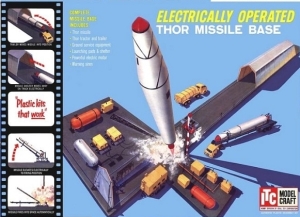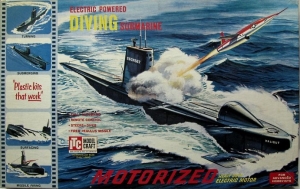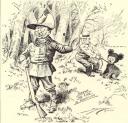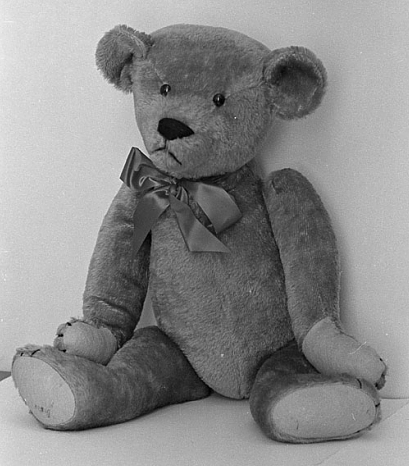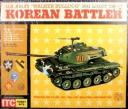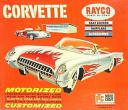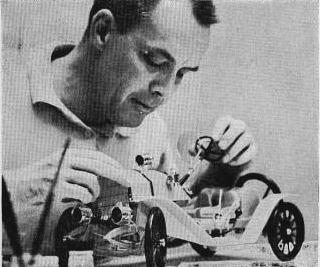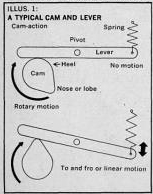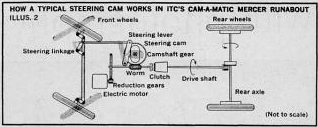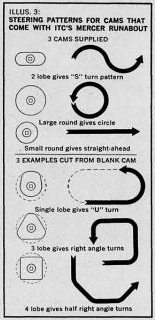by Alan Bussie
Every article starts with inspiration. In this case, I wish to thank Dusty Rhodes. He located critical information, the wonderful advertisement/article in Boy’s Life that is reproduced here and valued insight as well.
Almost every die-hard kit collector has heard of the ITC Thor Missile Base and Halibut Submarine models. The Thor is among (or is) the most valuable of all collectable models and the Halibut and other ITC Cam-A-Matic action kits are close behind. Both kits have fantastic action features. The Thor is automatically removed from the shelter, taken over the launcher, raised into position then fired! The Halibut dives, surfaces then removes a Regulus II missile from the hanger and fires it! They were (and still are) the most complicated operating plastic model kits ever created. But how did Ideal Toy Company come into being, and what was Cam-A-Matic action?
(Thor restored box art courtesy of www.Boxartden.com)
Penny Candy and Teddy Bears
Ideal Toy Company was founded by Morris and Rose Michtom. Both were Jewish-Russian immigrants. Morris came to New York in the 1897/99 time period and Rose came over in 1899. He was penniless and soon married Rose. They were a hard-working and very enterprising couple; soon had a store at 404 Tompkins Avenue in Brooklyn, NY that sold candy, notions and other penny items. Rose was also a seamstress, and to help make ends meet, she sewed plush toys that were also sold in the store. They both became American citizens in 1902.
Like everyone else, Morris and Rose followed the news and the press loved Teddy Roosevelt. In 1902 Teddy Roosevelt spared the life a bear cub during a unsuccessful hunting trip in Mississippi. His hunting partners had tied a bear up so he could shoot it, but he refused. Political cartoonist Clifford Berryman heard the story and created a cartoon that was published in the Washington Post newspaper on November 16, 1902. When the Michtoms saw the cartoon, they were inspired to create a stuffed toy bear. Morris urged his wife, who was a seamstress, to create a bear that resembled Barryman’s drawing. That evening Rose cut and sewed material into the shape of a bear, giving it buttons for eyes. Morris put it in the front window display with a sign that said “Teddy’s Bear.”
Morris Michtom, announcement of President Roosevelt’s trip and the original cartoon (click any to enlarge)
It was not long until someone came into the store wanting to buy the bear. In short order, 12 other customers asked to purchase it. Obviously the bear could be a best seller, but Morris was concerned about using the President’s name on a product. Reportedly he mailed the original bear to the White House with a letter asking if he could name the bear after the president. Roosevelt responded that they could, although he didn’t he how his name would help sales.
The first Teddy Bear
It is not known for certain if Rose & Morris had really created the first Teddy Bear; but suddenly everyone wanted one. Morris and Rose quickly realized that the profit margins on bears were much better than candy. They were onto something big, so they made candy during the day and sewed bears at night. But they could not keep up with the demand. The Teddy Bear swept the nation in popularity. Within a year the Michtoms stopped selling candy and dedicated their full effort to Teddy Bear production. Roosevelt and his Party used the Bear as their symbol in the 1904, and Roosevelt had Michtom bears placed all around the White House for public functions. Eventually, Michtom’s entire stock of bears was purchased by the wholesaler Butler Brothers. To maintain a supply, the Butlers backed Mitchtom in founding the Ideal Novelty and Toy Company in Hollis, Queens.
Ideal Toy and Novelty
With the run-away success of the bear, they naturally branched out into dolls. Dolls very very popular but terribly fragile. Ideal’s were nearly unbreakable due to a composition structure of compressed sawdust and glue. They were so successful that there were no less than 200 such styles of Ideal composition dolls produced. Ideal had established itself as an innovative company and they captured larger and larger parts of the market.
Early (probably 2nd) Ideal Logo and a modern view of the second factory (courtesy of Forgotten New York) (click any to enlarge)
Ideal understood promotion. Most dolls were designed after already famous personalities or characters such as “Uneeda Kid” (the National Biscuit Company character), “Yellow Kid” from the comic strip of the same name by Richard Oucault and many, many more. Among other things, Ideal invented ‘sleepy eyes’ in 1918 – when the doll was placed down, the eyes would close. Other ‘action features’ followed including ‘talking’ dolls.
Uneeda Kid, Pinocchio, early 1920s catalog cover and composition heads (click any to enlarge)
One of the most important Ideal products was the Shirley Temple doll. Many companies sold Temple dolls, but the Michtom’s was the most desired. Ideal’s Shirley was of high quality and came with realistic curly hair and famous outfits from her movies. The doll was so successful that in 1935 Ideal moved to a larger factory at 23-10 43rd Avenue in Long Island City.
Ideal Shirley Temple dolls and Disney Doll Display (click any to enlarge)
Ideal flourished during the Great Depression of the 1930s, while many businesses shut down or suffered. One line of dolls was from the incredibly popular Disney movies, such as Cinderella and Snow White. There was even a Judy Garland doll from the Wizard of Oz. However, one of the most famous dolls was not named after a an existing personality- “Betsy Wetsy.” Betsy was produced for over 50 years and was honored as one of the top 100 toys of the 20th century by the Toy Industry Association in 2003.
Early Betsy (click to enlarge)
Rose died Aug. 27, 1937 and Morris on July 21, 1938 in Brooklyn, NY. Their son Benjamin took over. He displayed excellent business sense and company growth continued. In 1941, Ideal hired future leader, Lionel Weintraub, as a part time summer worker. Weintraub was born in 1920 in New York city. His goal was to become a College Professor and teach English. To this end, he received a Masters in English Literature at Penn State. He intended on getting his PhD but a summer job in 1941 side-tracked him. When he ask his girlfriend about temporary employment, he discovered that her father was one of the owners of Ideal Toy Company! Meintraub spent his adult life working at Ideal, becoming president in 1962 and retiring in 1983. He had a nack for knowing what would sell and what would not. The toy market was always boom or bust; start-ups were common but few remained in business for very long. The founders of Revell and Aurora had learned the hard way that success in toys was very illusive. Lionel’s life-time contribution was so great that in 2005 he became a member of the Toy Industry Hall of Fame. He is credited with introducing hundreds of toys, including the first three-dimensional games like “Mousetrap!”, “Toss Across”, “Battling Tops,” “Kerplunk,” “Magic 8 Ball” and of course “Rubik’s Cube.”
But 1941 was also a big year for Ideal for another reason- the first two plastic injection molding machines were purchased. The hope was to make doll heads and body parts from plastic to replace the composition constructions. Ideal was not disappointed with the new material and the production potential; but to benefit fully, more factory space was needed. The perfect opportunity presented itself when Langer Printing went bankrupt in 1943. In the bankruptcy auction, Ideal reportedly bought the factory for pennies on the dollar. The Jamaica Avenue, Hollis location was soon booming with hundreds if not thousands of local employees. The company value increased from 2 to 11 million during the WWII years.
In the baby boomer times after WWII, the company became so successful that they sold dolls in at at least 5 countries and probably more. In 1953 the name was changed to Ideal Toy Company, later abbreviated ITC for model kit sales. Ideal embraced plastics, eventually installing 72 injection molding presses and putting their primary competitor, American Character Doll Company, out of business. But Ideal did not stop with dolls. They produced extensive and successful lines of wind-up toys, games, doll houses + furniture and much more.
Various Ideal products (click any to enlarge)
The Birth of ITC Model Craft
The leaders of Ideal watched as Gowland & Gowland’s Highway Pioneers changed the hobby world in the early to mid 1950s. Given the post-war innovation and experience with plastics, it was no surprise that Ideal moved into plastic model kits. Ideal, it seems, never acted rashly. Perhaps they waited to see if plastic models were going to be a flash in the pan. By around 1956, the growth of Revell, Monogram, Aurora, Lindberg and Hawk was enough to convince anyone that plastic model building was here to stay. Ideal jumped on the bandwagon and marketed kits under the ITC name.
The first year for ITC (called “Model Craft”) was 1957. Ideal did not date their early kits, but the opening page of the 1957 ITC Model Craft catalog proudly declares “This catalog marks the introduction of the ITC Model Craft Line…” Some sources have claimed that the first Ideal kits were from the “early 1950s.” And indeed, some toys labeled ‘models were marketed by Ideal pre-1957. However, these were sold under the “Ideal Toy Company” name and not ITC Model Craft and tended to be advanced toys and not scale kits. For example, Ideal made a 1956 Oldsmobile Starflite with 130 parts in the same year. It can be debated if this is a model kit or a toy; but it was certainly intended as a ‘take-apart & put-together’ toy, along with the large scale Corvette. ITC pressed these toys and others into ‘model service’ as part of the line. The Robert E Lee river boat or USS Constitution (true model kits and not toys) could pre-date 1957, but there are no dates on the boxes, instructions or parts. They simply say “Ideal Toy Company” and not ITC.
Ideal #3083 ’54 Corvette and ’56 Olds ‘Starflite’ (later the ITC Starfire)- courtesy of liveauctioneers.com (click any to enlarge)
Since most or all of the early Ideal kits were rolled into the ITC line, we will concentrate mainly on ITC kits but include Ideal information if available. At first glance, the “Model Craft” line seems fairly extensive; however, they were masters of marketing and often changed box art and/or kit numbers. Catalogs for Model Craft are known to exist for 1957 through 1963; earlier Ideal Toy Company Catalogs, if located, could identify earlier kits and the date of the releases.
Reference List of all ITC Plastic Model Kits
NOTE:
- The actual part number on the box is listed next to the photo
- At some point ITC dropped the price extensions
- If the part # of a photo is not known it is listed as (#?)
- Every effort was made to make this a complete list; but there are certainly mistakes! Please email me with corrections.
Aircraft
ITC 3646 B-29 Superfortress Cam-A-Matic
ITC 3654.1 Grumman Goose (motorized)
ITC 3655.8 Beechcraft Staggerwing (motorized)
ITC 3656.6 Beechcraft Bonanza
(courtesy of www.Boxartden.com)
ITC 3663-149 North American XF-108 With Booster and Launcher
ITC 3674-98 Piasecki VZ-8P Jeep
ITC 3676-98 Sikorsky S-62 Helicopter
ITC 3678-98 Northrop T-38 Talon
(courtesy of www.Boxartden.com)
ITC 3714.0 Northrop N156 (F-5A Prototype)
ITC 3721-98 Dornier Do-X
ITC 3722-98 Stinson Trimotor Eastern Air Service
ITC 3723-98 US Navy Goodyear Blimp K-68 (1957)
ITC 3724-98 Curtiss Condor American Airlines (1957)
ITC 3725-98 Martin MB-2 Bomber
ITC 3727-98 Grumman J2F-1 Duck
ITC 3728-98 Savoia Marchetti SM-55x
ITC 3729-129 McDonnell XV-1
ITC 3748.1 Spirit of St. Louis and Wright Flyer
ITC 3749.2 S-55 and Spad XIII
ITC 3750.3 F-86D and P-51D
ITC 3760.6 Grumman J2F-1 Duck
ITC 3761.4 Martin MB-2
ITC 3762.2 Northrop N156 (F-5A)
ITC 3764 Spirit of St. Louis and Wright Flyer
ITC 3765 S-55 and Spad XIII
ITC 3766 F-86D and P-51D
ITC 3782 Spirit of St. Louis and Wright Flyer (Bubble Card)
ITC 3783 S-55 and Spad XIII (Bubble Card)
ITC 3784 F-86D and P-51D (Bubble Card)
Missiles and Spacecraft
ITC 3662 Thor Missile Base Cam-A-Matic
ITC 3673 Explorer I Satellite with Interior
Ships
ITC 3600 SS France Ocean Liner
ITC 3647 Graf Spee Pocket Battleship
ITC 3648 N.S. Savannah (motorized)
ITC 3649 WW1 Subchaser
ITC 3658.2 USS Enterprise Carrier Cam-A-Matic
ITC 3660 Halibut Submarine Cam-A-Matic
ITC 3680 USS Oregon Battleship (motorized)
ITC 3681 Graf Spee (motorized)
ITC 3682 WWI Submarine Chaser
(3682)
(3862, sticker in different location)
Ideal 3684 Wheeler Express Cruiser
ITC 3698 SS Savannah
ITC 3700 Graf Spee
Ideal 3701 SS United States Ocean Liner
ITC 3702.8 Schooner Waterwitch with sails
Ideal 3711 Wheeler Express Cruiser
Ideal 3713 USS Constitution
Ideal 3714 Robert E. Lee
ITC 3718 Clermont
ITC 3719 Yacht Atlantic with sails (1957)
ITC 3720 Corsair II with sails
ITC 3732 USS Oregon Battleship
ITC 3747 Viking Ship and Chinese Junk
(courtesy of Box Art Den)
Ideal Precision Miniatures 3755 Viking Ship and Chinese Junk
Ideal Precision Miniatures 3756 Santa Maria and Mayflower
Ideal Precision Miniatures 3757 Southern Belle and Constitution
Ideal Precision Miniatures 3761 Two Speedboats
Ideal Precision Miniatures 3762 Sport Cruiser and PT Boat
Ideal Precision Miniatures 3763 Tugboat and Gertrude Thebaud
ITC 3775 Ship Gift Set (Tug, PT, Cabin Cruiser, Outboard Racer and Sailing Ship)
ITC 3776 Ship Gift Set (Chinese Junk, Santa Maria, Mayflower, Viking, Constitution)
ITC 3780 Outboard Racer and Sport Runabout
ITC 3781 Viking Ship and Chinese Junk
ITC 3802 US Coast Guard Rescue Boat
ITC 3803 WW1 Subchaser
Soldiers and Military Vehicles
ITC 3664 US Air Drop Paratrooper
ITC 3665 Mechanical Mule with Parachute
ITC 3668 Air Drop Tank with Parachute
ITC 3669.9 M41 Bulldog Tank Battlin Betsy Cam-A-Matic
ITC 3670 T113 With Parachute
ITC 3677 M41 Bulldog Tank Korean Battler
ITC 3810 PT76 Soviet Amphibious Tank
ITC 3811 BTR50 Personnel Carrier
ITC 3857 T92 Armored Tank with Parachute
ITC 3858 T113 Airborne Personnel Carrier
ITC 3859.6-200 Mechanical Mule
ITC 3863 US Army Tank
ITC 3864 Personnel Carrier
ITC 3866 Amphibious Tank
ITC 3867 Amphibious Personnel Carrier
ITC 3812 Frog Missile (motorized)
ITC 3868 Frog Missile (motorized)
Automobiles
1/8 scale
ITC 3603 1954 Corvette
ITC 3637.7 1913 Mecer Raceabout Cam-A-Matic
ITC 3638 Duesenberg
ITC 3671 1956 Pontiac Starchief
1/9 scale
ITC 3688 Harley Davidson
ITC 3800 BMW Racing Motorcycle
ITC 3801 Harley Davidson Motorcycle
1/10 scale
ITC 3686 Corvette
1/16 scale
ITC 3690 1951 MG TD (motorized)
1/19 scale
Ideal 3704 Ford Police Car ‘Dragnet’ 1955
1/25 scale
Ideal 3064 1957 Pegaso Sport
Ideal 3068 1958 Rolls Royce
Ideal 3079 1958 Mercedes Benz 300
Ideal 3082 1953 Jaguar XK120
Ideal 3084 1955 Ferrari
ITC 3602 1956 Ford Thunderbird
ITC 3691 Indianapolis Racer (motorized)
ITC 3692 1958 Mercedes Benz Saloon
ITC 3693 1953 Ferrari 166
ITC 3694 1956 Jaguar XK140 Motorized
ITC 3695 1956 Ford Thunderbird
Ideal 3701 Talbot
ITC 3702 1955 Ford Thunderbird
ITC 3706 MG TD
Ideal 3701 Porsche
ITC 3708 Indianapolis Racer 1959
Ideal 3709 1956 Lincoln Hardtop (1957)
Ideal 3710 1956 Lincoln Convertible (1957)
Ideal 3712 Lincoln Continental MkII (1957)
ITC 3773.9 Mercedes Benz
ITC 3703 Talbot
ITC 3872 1925 Ford Model T Pick Up Truck
ITC 3877 1951 Ford Victoria
ITC 3878 1940 Mercury Convertible
1/80 scale
ITC 3711.9 1900 Packard and 1910 Cadillac
ITC 3745 Ferrari and Jaguar XK120 – Precision Miniatures
ITC 3754 Buick LeSabre and Indy Racer – Precision Miniatures
ITC 3758 1910 Pierce Arrow and 1909 Stanley Steamer – Precision Miniatures
Ideal Precision Miniatures 3759 1914 Stutz and 1915 Ford Model T
Ideal Precision Miniatures 3760 1900 Packard and 1910 Cadillac
Ideal Precision Miniatures 3774 Antique Cars Gift Set (Pierce Arrow, Ford Model T, Stanley Steamer, Stutz and Packard)
Ideal Precision Miniatures 3790 Ferrari and Jaguar
ITC 3791 Ford Thunderbird and MG – Precision Miniatures
1/30 scale
ITC 3782 Indianapolis Racer
Figure Kits
ITC 3730 Tyrannosaurus Rex Skeleton
ITC 3731 Stegosaurus Skeleton
ITC 3737 Neanderthal Man
ITC 3805 Bubble Bee
ITC 3805 Tyrannosaurus Rex Skeleton
ITC 3806 Brontosaurus Skeleton
ITC 3807 Stegosaurus Skeleton
ITC 3808 Neanderthal Man
Dog Series
ITC 3814 German Shepherd
ITC 3815 Collie
ITC 3816 French Poodle
ITC 3817 Greyhound
ITC 3818-1.49 Boxer
ITC 3822 English Bulldog
ITC 3823 Fox Terrier
ITC 3824 Cocker Spaniel
ITC 3825 Scotch Terrier
ITC 3826 Beagle
ITC 3851 Lion – Marvel Metal Series
ITC 3852 Tiger – Marvel Metal
ITC 3853 Rhinoceros – Marvel Metal
ITC 3854 Giraffe – Marvel Metal
ITC 3855 Elephant – Marvel Metal
ITC 3856 Gorilla – Marvel Metal
Miscellaneous Kits
ITC 3705 Winchester Rifle
ITC 3712 Southern Pacific and Cabbage Stack Locomotives
ITC 3713 The General and Porter Locomotives
ITC 3750 Surrey and Fire Pumper
Ideal Precision Miniatures 3767 The General and Porter Locomotives
Ideal Precision Miniatures 3768 Southern Pacific and Cabbage Stack Locomotives
Ideal Precision Miniatures 3769 Casey Jones and Rocket Locomotives
Ideal Precision Miniatures 3770 Covered Wagon and Stage Coach
Ideal Precision Miniatures 3771 Surrey and Fire Pumper
Ideal Precision Miniatures 3772 Hansom Cab and Coronation Coach
ITC 3784 The General and Porter Locomotives
ITC 3785-3 Southern Pacific and Cabbage Stack Locomotives
ITC 3795-2 Surrey and Fire Pumper
ITC 3894-5 Covered Wagon and Stage Coach
(All of the Misc. kits above were issued as ITC and with the Precision Miniatures logo)
ITC also produced factory built-up and painted models for hobby shop sales displays. Many came with a decorated cardboard backdrop explaining the features of the models. The Precision Miniatures line also came built-up in a wall display case containing up to 24 different models. There were smaller displays containing fewer kits as well. The later is the most common ITC factory built display.
Cam-A-Matic Action
ITC was not content to simply make static models. Perhaps due to the ‘action’ background and novel features of the dolls and toys, Ideal’s leaders wanted their finest kits to have working features far beyond anything the modeling world had seen. The ITC engineers, lead by Cal Smith, certainly delivered. Many kits, such as the Graf Spee for example, were issued three ways: static, motorized and remote control. But even that was not enough; plastic modeling reached its operational zenith in a series of ITC kits that actually ‘worked.’ To market such advanced and complicated kits, the term ‘Cam-A-Matic’ was coined, and it accurately described how the new kits functioned.
Cam-A-Matic kits are still the most complicated operating plastic models ever created. Ships sailed in patterns and launched aircraft; submarines surfaced, dove and launched missiles; cars would run in squares, circles or a custom pattern, then run them in reverse, and turn their lights on and off. The obvious downside was price and complexity. The Cam-A-Matic kits sold for between $8.95 and $11.98. This was very expensive for a plastic kit and ITC soon discovered what Revell, Monogram and Renwal already knew – that price point created slow sellers. Additionally, they were marketed as typical models, but the complication was well beyond the average builder. Many younger modelers had trouble building these kits so they would operate as advertised. As complaints and requests for replacements came in, ITC hurriedly slapped a “For the Advanced Model Maker” sticker on some box top. For later Cam-A-Matic kits, this was made a permanent part of the box top.
The Cam-A-Matic line included:
USS Enterprise CV-65 (automatically sails a selection of patterns, launches aircraft, elevators move up and down)
USS Halibut Submarine (automatically dives and surfaces, removes a Regulus II missile from the hanger and fires it)
Mercer Raceabout (automatically a selection of patters via steering front wheels, lights turn on and off, reverses and has motor sound)
1934 Duesenburg Rollston JN Roadster (same action as Mercer)
Thor Missile Base (automatically removes Thor missile from storage, tows it to the launch pad where it is erected and launched)
B-29 Superfortress Bomber (automatically starts engines one by one, then taxies down the runway, then shuts down)
Battling Betsy Tank (climbs obstacles, moves in forward and reverse, turret rotates, fires magazine of projectiles)
ITC scored a marketing coup when the sponsered the “Maverick” TV show. The USS Enterprise, Mercer Raceabout, B-29 and Halibut Submarine appeared on commercials. To celebrate this, ITC put stickers on the box tops stating ‘Seen on TV Maverick.’ Theses kits can be found with or without this sticker.
The following article (actually a long advertisement) was found in Boy’s Life Magazine (Oct. 1962) and explains exactly how Cam-A-Matic works.
CAM-A-MATIC – A Mechanical Brain For Model Kits
By Cal Smith, Technical Consultant to ITC
Cal Smith, shown with an ITC Mercer Runabout. A specialist in control line, radio control models,
he has designed over 100 original models and written articles for aviation and modeling magazines.
While visiting the local hobby shop recently I overheard a modeler ask the dealer: ‘What is this Cam-A-Matic action?” He was eyeing an ITC kit, of course. Listening to the dealer explaining Cam-A-Matic, it occurred to me that many modelers might like to know more about this unique mechanical system. Just how does Cam-A-Matic work? What will it do?
First of all, the Cam-A-Matic system is an unusual extra feature found only in ITC plastic model kits. There are many excellent, highly detailed plastic scale models for display. There are also plastic models powered with rubber bands, CO2 cartridges, electric motors and gas engines that will run straight ahead, along a wire or round-and-round, tethered to a pylon. But the only model with a mechanical brain that automatically guides it through a pre-arranged pattern of action or course of travel is the ITC Cam-A-Matic. In addition, by swapping cams, different action patterns can be created.
HOW DOES CAM-A-MATIC WORK?
Let’s begin with the cam itself. What is cam? The physics book defines a cam as “…a device for changing a rotary motion into a to-and-fro motion, or vice versa.”
Cams are a basic part of all reciprocating engines. Their most familiar use is in the automobile engine, where cams are used to open and close the valves. A cam is also an essential part of the auto ignition system in the distributor.
Cams can be of many shapes, depending on their application. Some may be simply circular and mounted off-center on a shaft. Another may be egg-shaped, nearly circular, but with a high spot or bump at one side called the nose or lobe. Others may have two or more lobes. Cam action is quite simple: as the cam rotates, the lobe moves against a lever or rod causing it to move. When the lower or heel portion of the cam is swinging past the lever, no motion is imparted to it. Thus the linear motion of the lever can he used to perform a mechanical task at a given interval. (See Illustration I)
HOW CAMS WORK IN AN ITC MODEL
As used in an ITC Cam-A-Matic model, several cams operate the various action features by having the cam lobes move levers or switches. Take, for example, the ITC Mercer Runabout that you see me working on in the picture above. Its Cam-A-Matic system has four cams which perform four different functions. One actuates the steering linkage. (To see how look at Illus. 2) A second engages and disengages the clutch, a third switches lights off and on and the fourth flips the forward-reverse switch. The steering and clutch cams moves rods and levers to turn the front wheels and stop the car. The light and forward-reverse cams move the switch parts directly.
Motive power for both the Mercer Runabout’s propulsion and the Cam-A-Matic system is furnished by a powerful 4.5 volt electric motor, turning the main drive shaft through reduction gears. Three “D” size dry cell batteries furnish the current. The drive shaft has two parts with a clutch between, so that motor power is applied to or disengaged from the rear wheels, just as on a real car. A separate shaft for the four cams is driven by a worm and gear from the main drive shaft. (See Illustration 2)
How A TYPICAL STEERING CAM WORKS IN ITC’s CAM-A-Matic Mercer RUNABOUT
Because of the reduction gears, the camshaft makes only one revolution in about 20 seconds. At this point the reversing switch acts, and the sequence repeats in reverse, completing the action cycle in about 40 seconds. This complete cycle will repeat itself as long as the switch is kept on. The cam positions and slow shaft rate combine to determine the timing and sequence of actions.
ITC CAMS ARE INTERCHANGEABLE— CAN BE USED MANY WAYS
Four interchangeable steering cams are supplied in the Mercer and also in ITC’s new Duesenberg Cam-A-Matic model kit. Three of the cams are for different steering patterns, pre-set by the shape of the cams. The fourth cam is a round blank. That’s where your ingenuity comes in. You can cut that cam to a new shape that will add still another pattern of action for your Cam-A-Matic car model. Take a look at Illustration 3 to see which cams perform each function and also to see a couple of my ideas for how you can use the extra blank cam.
The two-lobe cam steers the car in an “S” pattern. The car will travel forward while turning right and left, stop, and then turn while travelling in reverse.
The second, large round cam guides the car in a left-hand circle of about 6 ft. diameter. It will stop midway, then start again to complete the circle. It then reverses, stopping midway again, and completes the circle in reverse. The third, small round cam permits straight-ahead operation. With this cam, the car travels forward for about 10 feet, stops, then continues forward another 10 feet and stops. It then reverses and travels back to the starting point, stopping once midway. During all these steering actions, the car’s lights are turned on and off at intervals. It is a most realistic sight, especially if the car is run at night.
Now take your fourth cam, the blank one. (See Illustration 3.) By cutting the blank with one lobe, a “U” turn pattern can he made. The heel of this cam should be cut to the same diameter as the straight-ahead cam through an arc of about 200 degrees. The remainder or lobe should be left the full diameter of the blank.
NOTE: All Cams in ITC Cam-A-Matic kits work on the same principals. They vary in their
shape in order to accomplish different actions, depending on the nature of the model.
A long oval pattern can be made with this single lobe by removing the reversing switch manually for forward (or reverse) travel.
A three lobe cam, with flat sides in the shape of an equilateral triangle will give approximately right angle turns and an 8 ft. square pattern.
A four lobe cam, or square, will produce short, straight travel with a series of half right angle turns.
HOW TO CUT YOUR OWN CAMS
When cutting different cams, making the heel portion equal in diameter to straight-ahead cam will give straight runs and left turns. To produce right turns make the heel diameter less than straight-ahead cam diameter. When a cam is removed to eliminate its particular function, replace it with a spacer of equal thickness. It can be a length of brass tubing or a spare eyelet.
Additional steering cams can be made of 1/8″ thick plastic or hardwood plywood. Drill a 3/32″ diameter hole and cut hole square with a square needle file. File for snug fit on camshaft. The blank cam that is supplied with the ITC kits can be easily be cut with a razor saw and trimmed with a flat file.
Even after you have all your cams cut and trimmed for your individual plans of action, there’s still more variety you can get in the action of ITC’s Cam-A-Matic. Simply by changing the position of the steering cam on its square camshaft, the steering action will occur at different times during the forward-reverse sequence. Remove and rotate the cam 90 degrees, then replace on camshaft. This trick can be used on other cams; different positions will give different action combinations.
Another variation you can make is to convert the reversing switch to manual operation by removing the reversing cam. Cement a 1.5″ length of plastic “tree” (sprue) to the lower end of the switch slide so that it projects below the gear box. This extension can then be easily reached under the car for switching from forward to reverse.
You can see from all this that there are many variations on the Cam-A-Matic theme. Any modeler can use his ingenuity to dream up others. In this way the full potential of ITC’s Cam-A-Matic model kits can be realized and appreciated.
(End of advertisement/article)
ITC Sales and Marketing Strategy
Some important details are known today because choice pieces of wholesale distributor advertising still exist. In any advertising there is some showmanship involved, but it does provided an important look into what Ideal thought they could do.
Distribution
Ideal assumed successful ITC distribution through the vast wholesale network for the common toy line. For 1960, they estimated the annual value of the US ‘hobby market’ (model kits) at about 100 million dollars.
Product Philosophy
ITC’s new products were marketed as “Kits That Work.” This was a strong theme in product development and clearly the motivator behind Cam-A-Matic, Remote Control and motorization. Ideal had long been making dolls and toys with innovative ‘working’ features. Given their toy market dominance, they assumed this strategy would work as well for model kits. Since almost all new kits had some of these features, ITC was betting the bank on it. Such kits were complicated and the primary target group was young adults.
Product Line
Cars: The majority of mid-sized car kits were simply re-labeled Ideal toys/models. They can be found with and without “ITC” stickers. There were some new molds and two were Cam-A-Matics, however. Ideal eventually updated many of the boxes. Motors were added to some. This resulted in a proliferation of part numbers that made the line appear much larger than it really was.
Airplanes: All of these molds were new and released under the ITC label. One aircraft was Cam-A-Matic and several others were motorized.
Ships: The SS United States, Wheeler Express Cruiser, USS Constitution and the Robert E. Lee were originally issued under Ideal, as were the Precision Miniatures. All others were originally issued as ITC. Many ships were issued motorized and even as ‘Remote Control.’ For example, the Graf Spee could be purchased three ways: static, motorized or RC. Again, this made the line look much larger than it really was.
Dogs: All released under the ITC label
Figure Kits: All dinosaurs and the lone human figure were originally issued as ITC
Small Scale Models: Ideal’s previous “Precision Miniatures” were released by ITC, not only in new boxes but in blister packs as well. Ideal got a lot of mileage from this line – it had a very low price point.
Marketing
ITC sponsored a major network TV program, Maverick. During commercials, ITC had excellent spots promoting the premium Cam-A-Matic kits: USS Enterprise, Halibut Submarine, 1911 Mercer and Battling Betsy tank. This was the first time that model kits sponsored a prime-time TV show; it could not have been cheap. Ideal also ran ads in magazines such as Boy’s Life and produced annual catalogs as well.
Given what Ideal knew at the time, the strategy appeared sound. However, the opposite was true.
The End of ITC Hobby Craft
Ideal went on to become one of the top three toy companies in the USA, but ITC Hobby Craft kits vanished well before that. What happened?
Either ’63 or ’64 was the final year for kit production, since the last ITC catalog was dated 1963. After that, a warehouse (or more) full of kits was sold under the name Ringo. What was Ringo? Even to this day, it is not clear. Either ITC marked them under ‘Ringo’ or they sold the stock to someone who used the name. Given the subtle logo changes on some kits, it appears that ITC used the name. But either way, they clearly did not want their name associated with these remaining kits. When you look at Ringo kits, it is easy to see why. Although some can be found complete, the following discrepancies appear more often than not:
- Missing decals
- Missing clear parts
- Missing specific ‘action’ features (such as a motor) clearly shown in the directions
- Incorrect instructions (i.e. action instructions in a non-action kit)
Selling these kits under the ITC name would have been a public relations disaster!
A small sampling of the Ringo releases (click any to enlarge)
But exactly why did Ideal shut down ITC Hobby Craft? Since most companies do not promote or explain their failures, there are no certain details. So the following is conjecture.
Profitability
Clearly no company would discontinue a profitable line. Obviously, ITC was not profitable because it was terminated. A careful look at the strategy and product line gives some potential clues.
“Models That Work” = Complexity and Price
In the golden age of plastic kits, complexity never ensured a great selling model; actually, the opposite was true. Complex kits were expensive to make. Not only did they require much more R&D and tooling, but the actual parts (metal contacts, shafts and chains, wire, electric motors) added to the cost of the kit. When Aurora’s common kits were selling for 39 cents to $1.30, the Cam-A-Matic cars were almost $9. To put this into further focus, Aurora’s ‘Giant Bombers’ line was $2.59 and they were very reluctant to expand that series, choosing instead to concentrate on lower price point kits.
Complexity also leads to complaints. Simply including a motor with a kit greatly increased the chances that the customer would fail to build the kit correctly or be disappointed. The extreme of this was found in the ‘Cam-A-Matic’ series. It is important to remember that one big reasons for toy giant A.C. Gilbert’s collapse was the complicated and flawed James Bond slot car road race set from 1965. Although ITC kits were not fatally flawed like the race set, there are parallels.
Product Line Detail and Scale
In the early days of modeling, kits would sell on the basis of box art and novelty alone. But just as Aurora discovered in the later 1960s, young boys grow up and public tastes change through exposure. The same poorly designed kits from the 1950s did not sell to a more ‘kit educated and discerning’ crowd.
To make matters worse, ITC pressed many Ideal models into use as scale kits. These were little more than toys that had not been assembled, a trick that Revell had tried early on. They consisted of a handful of parts and were out of scale. Possibly due to complaints, ITC even put large stickers on these kit stating that they were for beginners. A good example is the “1956 Thunderbird.” The scale is listed as 1/24, but it measures closer to 1/21. Even worse, it is very difficult to determine if the kit is a ’55, ’56 or 1957 Thunderbird. From the details (and even the shape), it is none. Perhaps that is why ITC simply listed it as a “Thunderbird” in later issue. Some box art shows the car adorned with side trim that was never used on any early Tbird! It is difficult to imagine any sales potential for this kit in the 1960s, although today it is popular with collectors.
As for the new molds that ITC cut, a complex kit does not make a good “scale” kit. The working features often (and necessarily) detracted from scale detail. The wonderful Halibut sub, for example, is not even close to a scale representation of the real thing. The USS Enterprise is closer but still suffers from the required addition of working features; and Aurora’s superb kit from 1961 put it to shame. When the novelty of the features wore off, the actual kit had little to no appeal for more serious model builders – and that was the target audience.
Marketing
The TV show ‘Maverick’ was also sponsored by Kaiser Aluminum, implying that ITC bet a fortune on this sponsorship. In retrospect, there may have been better places to put this money – both on TV and off.’
ITC did not spend a great deal on box art. Most of it screams ‘Action Toy’ (thanks Dusty!- ab). Every major model manufacturer did a much better job representing their product on the store shelves.
Distribution
Ideal assumed that with its vast toy network that placing their model kits on shelves would be a snap. Initially this was the case; but clearly they quickly ran into problems.
- Many of the ITC magazine advertisements mention finding the kits in Grants, which is admirable but far from perfect. Some ads as late at 1959/60 mention that if you can’t find the model in a dealer, send direct to ITC for the kit with “25 cents to cover postage and packing.” It is hard to believe that such a giant toy maker would need to resort to direct sales unless there was an issue somewhere. Monogram, Aurora and Revell never had this problem. Revell’s founder, Lew Glaser, learned early that distribution and shelf space was everything. That was the key to the rocket-like performance of the 1/32 Highway Pioneers.
- Models were niche items and had to be placed correctly. Some modelers remember ITC kits placed in with toys, which certainly would not help. The right shelf space, which sold fast-moving Aurora, Revell or Monogram kits, would not be easily abandoned for high-price point products that were untested.
- Ideal had no marketing penetration to hobby shops, which is where the serious, young adult bought many of his kits. Back then kits were sold at a large variety of locations, but the hobby shop was important also.
Cooperation With Other Manufacturers
It only took a few mistakes for Hawk, Aurora, Monogram, Revell and Lindberg to prove what we know now: if two companies each make a kit of the same thing, both will lose. The market is simply not that big, even back then. So the main players had a ‘gentleman’s agreement.’ Each kept the other informed of what they were doing to avoid mold duplication. This ensured a good return on the huge investments of prototyping, design and mold-cutting. ITC apparently did not take part in the agreement, or thought the action features would set them apart. As a result, the USS Enterprise had a very short sales life due to the superior Aurora kits introduction in 1961. The same happened to Battling Betsy when Renwal introduced its own excellent Bulldog tank kit. Since ITC was betting so much on so few brand-new kits, the ill effects would be magnified.
Overproduction/Coordination
It is shocking to see the sheer variety and quantity of Ringo kits that survive today. ITC clearly had a warehouse (or more) full of unsold kits. Clearly, kits were being made and stocked in anticipation of orders that did not materialize. The lack of decals, clear parts and ‘working’ parts in Ringo kits means that ITC did not have them to pack in the kit boxes. That implies that primary injection molding production was not well coordinated with the peripheral parts needed to complete the kits. The inability to control production to meet demand is expensive in raw materials, labor, floor space and perhaps taxes. Additionally, a warehouse of unsold items is disappointing to the company executives. This would not have escaped the eye of Lionel Weintraub, who became president in 1962. He may have realized ITC’s lack of profitability and had a hand in its demise.
Conclusion
From our comfortable perspective, the reasons for the demise of ITC Hobby Craft appear obvious. But ITC had no idea what would happen; they were in on the birth of the modern hobby industry. They took a gamble and should be be commended on doing so. And if were not for ITC, we would still not have kits of some fantastic subjects. And we would not have some of the most valuable collector kits today- the fantastic Cam-A-Matic series!

